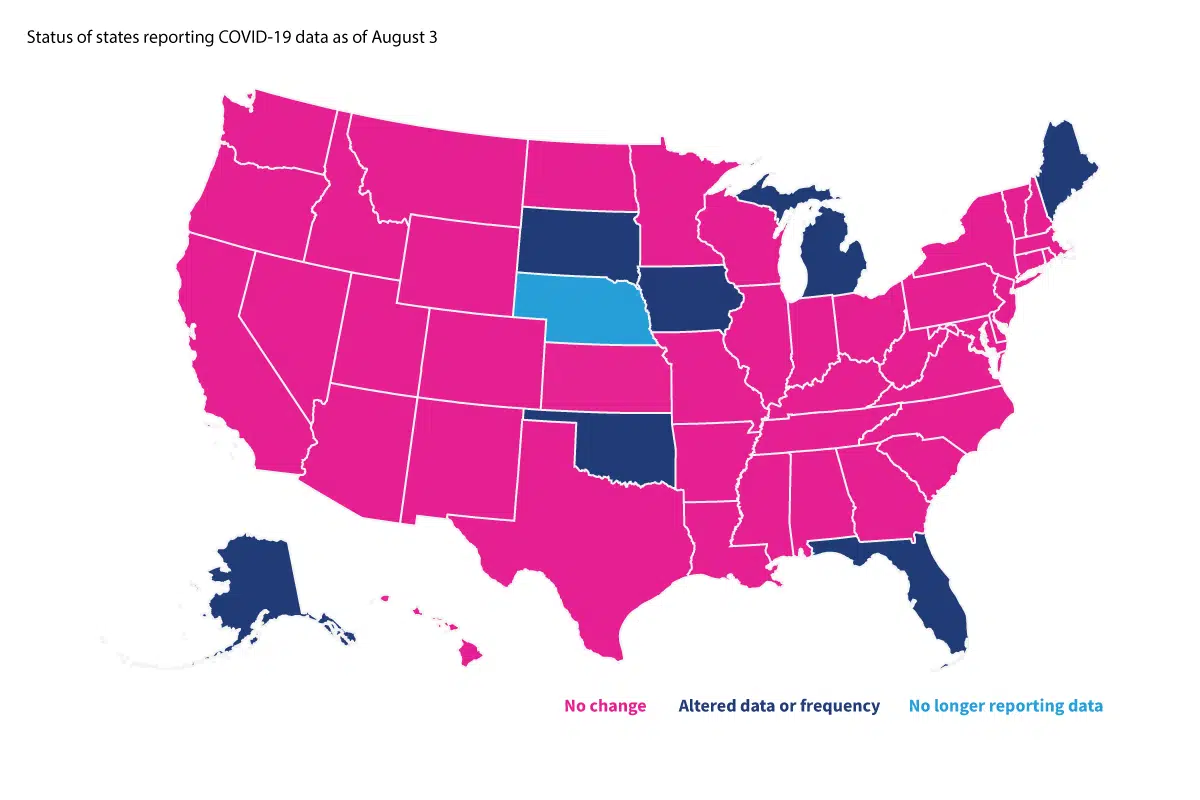The Delta variant has underscored that this pandemic is not over, but several states have ceased or slowed reporting COVID-19 case and death data. These lapses in data could make it difficult for citizens, state officials, and federal policymakers to understand how lifted restrictions, vaccination efforts, or reinstated mask mandates are impacting this new phase of the virus.
Over the last month or so, several states have reduced the frequency at which they report. Most states are still reporting cases and deaths, but the frequency and type of reporting have changed from earlier in the pandemic.

As of August 3, data reporting across the nation looks like this:
- Nebraska no longer reports its cases and deaths. The state discontinued its COVID-19 dashboard as of June 30.
- Florida also discontinued its dashboard at the end of June. It now publishes a PDF once a week, but the information is uneven: cases are on a county level, however, reported cumulative deaths are for the state overall.
- South Dakota is also reporting once a week.
- Michigan reduced its reporting to Tuesdays and Fridays.
- Maine no longer reports on Mondays.
- Alaska has reduced reporting to Mondays, Wednesdays, and Fridays.
- Oklahoma reported COVID-19 data daily until March 14. Now it reports between one to three times a week.
- Iowa has not announced any changes but has reported just once a week since July 21, a change from consistent daily reporting.
- Also, most states have discontinued reporting on the weekends over the last month or so. Thirty-seven states didn’t report on Saturday, July 24, and 41 states didn’t report on Sunday, July 25.
Uneven reporting in this ongoing pandemic makes for several challenges. For one, it’s more difficult to track hotspots. Plus, it’s hard for the nation to assess how it’s progressing (or regressing) as a whole. It also complicates data reporting for USAFacts and similar resources that collect and visualize data so Americans can make informed decisions. National counts from any given day are incomplete; overcoming these data issues requires increased reliance on seven-day totals and averages.
Throughout the pandemic, states hammered out methods for reporting. The systems are in place and people still need data. Funding and staffing could partially be behind this decline in reporting. Nebraska's reporting stopped around the time Governor Pete Ricketts declared the end of the COVID-19 state emergency on June 28. Twenty-six states are no longer under a state of emergency; many states ended their states of emergencies in June while Delaware ended its emergency on July 12. However, many of these states still report COVID-19 data every weekday. Americans deserve numbers to make informed decisions about health risks, work, school, and more. Discontinuing reporting systems means driving blind.
For much more data on the pandemic, from vaccination rates to economic recover indicators and more, visit the USAFacts COVID-19 Hub. See more on the spread of Delta and other coronavirus variants right here.







